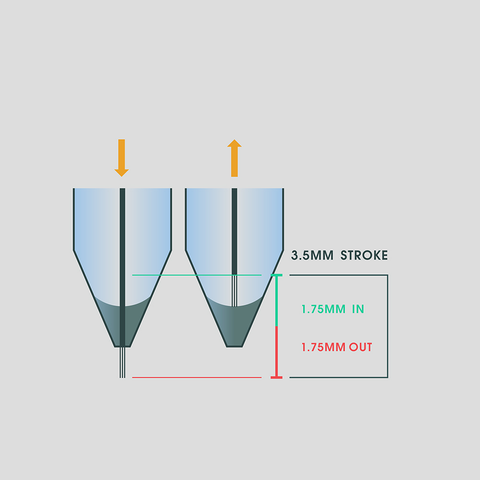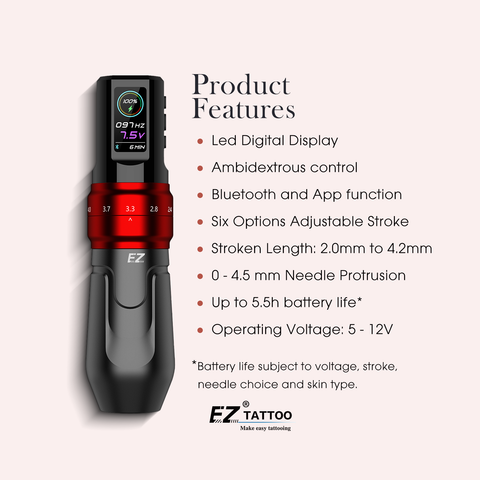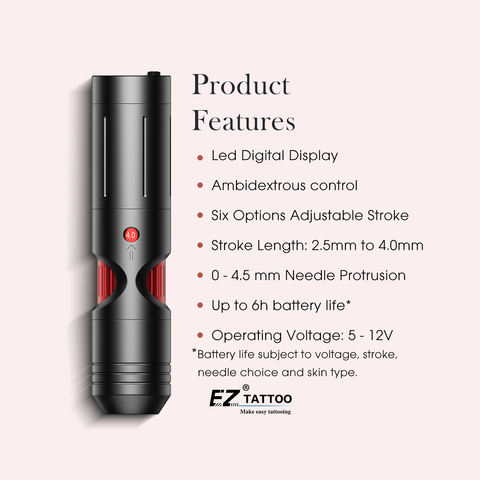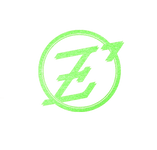EZ TATTOO OFFICIAL
With over 23K+ orders

Tattoo Machine Stroke —— How to choose the right stroke length for you?
What is machine stroke?
The stroke of a tattoo machine refers to the distance traveled by the armature bar, from its most upright position to its most down position. In rotary tattoo machines, the stroke indicates the travel required for one rotation. The length of the stroke increases as the bearing moves farther away from the center of the cam.

|

|
Needle Tip |
Machine stroke, in contrast to needle depth, pertains to the distance the needle hangs out of the tube. It's important to note that needle depth does not impact the machine stroke. However, one may opt to adjust the machine stroke to accommodate a different needle depth if necessary.

|
3.5mm Stroke |
Tattoo machines offer a range of stroke sizes or the capability to adjust the stroke within a specific range, such as 1.8mm to 5mm.
- Short Stroke Length: 1.8 – 2.5 mm. Short stroke machines move faster because they have less distance to travel in each up-and-down motion.
- Medium Stroke Length: 3.5mm. This is widely used by tattoo artists. If a tattoo machine is not adjustable, it most likely will come with this stroke length, or one very close.
- Long Stroke Length: 4mm+. Long stroke machines hit harder because they have more space to “wind up” before hitting the skin.
Why is machine stroke important?
The machine stroke determines:
-
How hard the machine hits.
-
How fast the needle moves.
-
Your max needle depth.
How hard the machine hits. By traveling a greater distance in each upward and downward motion of the needle bar (in the case of a coil tattoo machine) or cam wheel (in the case of a rotary tattoo machine), a longer stroke provides the needle with increased momentum. This enhanced momentum empowers the machine, enabling effortless utilization of larger needle groupings.
How fast the needle moves. How quickly the needle moves in and out of the tip.
The max needle depth. When utilizing a short stroke, the extension of your needles is restricted. In each upward and downward motion, the needle's depth must be sufficiently short to access the ink inside the tip of the tube.
When to use different strokes?
A shorter stroke (1.8-2.5mm) is good for applying soft black and grey. Creating layers of ink often necessitates multiple passes in this style. The stroke's gentler impact allows for the creation of seamless blends without causing excessive skin damage. However, a short stroke is unsuitable for lining purposes. It lacks the necessary power to accurately guide the lines, and if the needle is set too deep, it fails to fully retract into the tube with each cycle. Consequently, the needle is unable to replenish ink from the tube tip, making it nearly impossible to achieve solid lines in a single pass. Moreover, lining necessitates extending the needle further out of the tube for improved precision, which is unachievable with a short stroke. As a result, ink gathers on the skin, potentially obscuring the stencil. Short stroke machines, to recap, are ideal for clients with thin to medium skin thickness in all areas of the face (brows, lips, and eyes). However, it is advisable to avoid using them on thicker or resistant skin.
A medium stroke (3.5mm) is best for packing color and blending.With a medium stroke, you can effectively execute lining using smaller needle groupings; however, when it comes to larger groupings, it may encounter difficulties. It also allows for the application of black and grey shading, although it may not deliver the desired level of smoothness required for highly detailed portraits that typically entail multiple passes. For medium stroke machines, we recommend the EZ P2S (3.5mm stroke length)

|
A longer stroke (4.0+mm) is typically only used for lining, as it packs in ink with hard-hitting strokes. With ease, it readily propels large needle groups into the skin and permits you to extend the needle farther out of the tip, enhancing precision during the lining process. Nonetheless, this attribute renders it an unfavorable option for shading, necessitating multiple passes. Longer strokes pose a significant challenge for achieving seamless blends, and the repeated passes required for shading can excessively strain the skin, potentially resulting in scarring. For longer strokes, remember that the needle stays in the client's skin longer and applies more pressure, causing skin trauma despite machine give. To avoid overworking a small area and minimize additional trauma, work quickly when pulling a line with a very long stroke. For longer stroke machines, we recommend the EZ P2S (4mm stroke length)

|
|
Q: Is there a machine that includes all the strokes? A: Of course, our EZ P3 pro and EZ P3 contain all the strokes ----both with six adjustable stroke length. |

|

|
|
Q: What stroke does my machine have? A: The machine’s stroke or possible stroke range will be listed when you buy your machine. Some tattoo machines can be adjusted and others cannot. You will need to know this about your machine before purchasing. |
|
Q:Why is an adjustable stroke important? A: As a tattoo artist, you will need to have a short, medium, and long stroke available. If your tattoo machine does not have an adjustable stroke - or you don’t know how to properly change the stroke - you will have to buy three separate machines, which can be costly. |
In addition to this, our EZ P3 Pro Advanced Bundle is equipped with the tattoo artist's basic items for the tattoo artist during the tattooing process while meeting the needs of the tattoo artist's itinerary.

|




